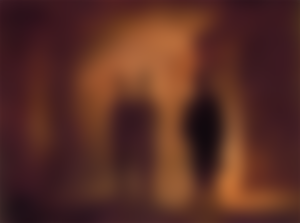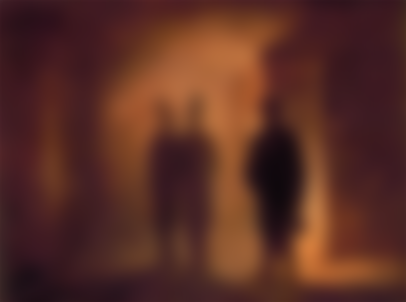A Slavic witch, a monumental entrance in the Ukrainian capital, and a French abode of the dead are three stations of ten, in a picturesque walk in sound. Who is the creator?
This was a quiz I once created for a magazine, and the answer is Modest Mussorgsky; the walk in sound refers to his musical composition "Pictures at an Exhibition" [Картинки с выставки]. "Walk" is a special clue since a returning theme is called "Promenade", "picturesque" naturally refers to the pictures of the title, which are also the basis of the composition; Baba Yaga is a Slavonic witch whose hut has given name to one of the "pictures"; "a monumental entrance in the Ukrainian capital" is a clue to another one, "The Great Gate of Kiev"; and " a French abode of the dead" refers to "The Catacombs".
The last one can be confusing, because the subtitle is sometimes given as "Sepulchrum Romanum", and then it is close at hand to interpret it as the Catacombs of Rome, but the term just defines it as catacombs, as opposed to other sepulchres. According to Stasov, the picture on which this is based, a painting by Viktor Hartmann, clearly identifies the location to Paris.
The picture hangs at State Russian museum in St. Petersburg. One of the men allegedly is Viktor Hartmann himself.

Viktor Alexandrovich Hartmann (1834-1873) was a Russian architect and painter. In 1870, Vladimir Stasov, another painter, introduced him to a circle of composers, called “The Five”, which included Modest Mussorgsky; Hartmann and Mussorgsky became close friends.
The year after Hartmann's death, a large number of his works were shown at an exhibition in Saint Petersburg; of the more than 400 paintings, most of them are now lost. Mussorgsky (1839-1881), however, saw them and chose ten of them as basis for his composition, “Pictures at an Exhibition”, 1874. It is a suite for piano and was something radically new at the time. Apart from “Promenade”, a theme binding together the pieces, the suite consists of:
“The Gnome”.
“The Old Castle”.
“Tuileries”.
“Cattle”.
“Ballet of the Unhatched Chicks”.
“Samuel Goldenberg & Schmuyle”.
“The Market at Limoges”.
“The Catacombs”.
“The Hut on Fowl’s Legs” (The Hut of Baba Yaga).
“The Great Gate of Kiev”.
Mussorgsky was, as several of the best known Russian composers of the time, a musical amateur, and his style was unpolished. Nikolay Rimsky-Korsakov polished “Pictures at an Exhibition” before the score was published, but Mussogsky's original score has later been made available as well.
Many arrangements and interpretations have been made. Maurice Ravel's version for orchestra is the best known; indeed, it is so well known that it rivals the piano original in fame.
Other noteworthy versions are a live album from 1974 by progressive rock group Emerson, Lake & Palmer, and a synthesizer version from 1975 by Isao Tomita.
Russian artist Wassily Kandinsky, made a series of paintings inspired by Mussorgsky's music. They have nothing to do with Hartmann's original pictures. So paintings inspired to music, which inspired to new paintings.
The image below is a portrait of Modest Mussorgsky, painted by Ilya Repin in 1881, just a few days before his (Mussorgsky's) death. It is one of the finest portraits in Russian art.

Almost a month ago, I published “The Kreutzer Sonata: How Art Inspires to Art, which Inspires to Art...“, in which I discussed how art can inspire to new art, also over the borderline between disciplines. In a comment, @whitecatascend asked for more in the same style. That inspired me to this article, with one of my favourite composers in centrum.
Pictures at an Exhibition - a very rich suite, containing a large number of styles and musical expressions - remains Mussorgsky's most famous work. For me personally, it has been with me since my childhood. For years I heard it, and I practised it in endless piano lessons, and I always wondered about those pictures. Where were they? How did they look? When, finally, I learned about Hartmann, I was disappointed that only a few pictures were preserved. To be honest, I was also disappointed over those that were preserved, because they were quite uninteresting and mediocre pieces of art. I am still at a loss to understand how they could inspire Mussorgsky to such a remarkable music.
Related article:
The Kreutzer Sonata: How Art Inspires to Art, which Inspires to Art...
Pictures at an Exhibition - Resources:
Piano version: https://youtu.be/rH_Rsl7fjok
Ravel's version for orchestra: https://youtu.be/FsvpFU7KY7E
Emerson, Lake & Palmer: https://youtu.be/4igIQ2TOASg
Isao Tomita: https://youtu.be/IVvQQMrEUzQ
Boris Ivanov: https://www.borisivanovmusic.com/concert
Jorge Caballero (classical guitar version): https://youtu.be/5tcw4WhTPHk
Wassily Kandinsky's pictures, based on Mussorgsky's music: https://www.wassilykandinsky.net/pictures.php
Copyright © 2021 Meleonymica/Mictorrani. All Rights Reserved.
Here you can find my articles about History, Art and about Music.
Interested in history, legends and myths, join my community History, Myths, Legends & Mysteries (be45).
You find all my writings on Read.Cash, sorted by topic, here.
My 5 most recent articles:
On the Genealogy of Script III - VIII
On the Genealogy of Script I & II
Anagrams, Palindromes, Cryptarithms And Alphametics
Rhyme & Reason: Verse, Structure, & Memory
Retrospection 5 (About Privacy, Freedom and Politics.)


As a musician I'm quite familiar with Pictures of an Exhibition; I was 14,15 when I played them for the first time. Quite a challenging piece, and the conductor made sure in each picture to tell us some of the story behind it. Reading this article, brought back so many memories about that time. Thank you!